Xuesu Xiao
GMU
Learning from Hallucinating Critical Points for Navigation in Dynamic Environments
Sep 30, 2025Abstract:Generating large and diverse obstacle datasets to learn motion planning in environments with dynamic obstacles is challenging due to the vast space of possible obstacle trajectories. Inspired by hallucination-based data synthesis approaches, we propose Learning from Hallucinating Critical Points (LfH-CP), a self-supervised framework for creating rich dynamic obstacle datasets based on existing optimal motion plans without requiring expensive expert demonstrations or trial-and-error exploration. LfH-CP factorizes hallucination into two stages: first identifying when and where obstacles must appear in order to result in an optimal motion plan, i.e., the critical points, and then procedurally generating diverse trajectories that pass through these points while avoiding collisions. This factorization avoids generative failures such as mode collapse and ensures coverage of diverse dynamic behaviors. We further introduce a diversity metric to quantify dataset richness and show that LfH-CP produces substantially more varied training data than existing baselines. Experiments in simulation demonstrate that planners trained on LfH-CP datasets achieves higher success rates compared to a prior hallucination method.
Efficient Multi-Agent Coordination via Dynamic Joint-State Graph Construction
Sep 08, 2025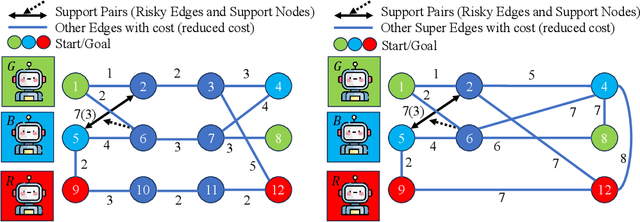


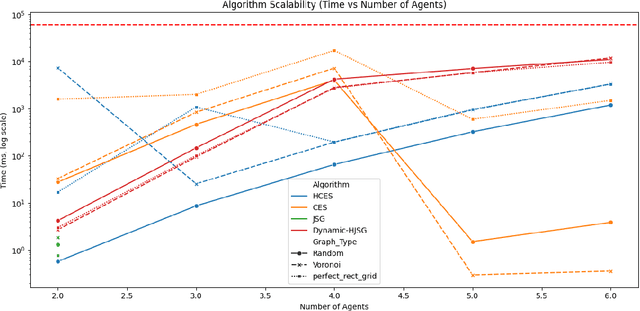
Abstract:Multi-agent pathfinding (MAPF) traditionally focuses on collision avoidance, but many real-world applications require active coordination between agents to improve team performance. This paper introduces Team Coordination on Graphs with Risky Edges (TCGRE), where agents collaborate to reduce traversal costs on high-risk edges via support from teammates. We reformulate TCGRE as a 3D matching problem-mapping robot pairs, support pairs, and time steps-and rigorously prove its NP-hardness via reduction from Minimum 3D Matching. To address this complexity, (in the conference version) we proposed efficient decomposition methods, reducing the problem to tractable subproblems: Joint-State Graph (JSG): Encodes coordination as a single-agent shortest-path problem. Coordination-Exhaustive Search (CES): Optimizes support assignments via exhaustive pairing. Receding-Horizon Optimistic Cooperative A* (RHOCA*): Balances optimality and scalability via horizon-limited planning. Further in this extension, we introduce a dynamic graph construction method (Dynamic-HJSG), leveraging agent homogeneity to prune redundant states and reduce computational overhead by constructing the joint-state graph dynamically. Theoretical analysis shows Dynamic-HJSG preserves optimality while lowering complexity from exponential to polynomial in key cases. Empirical results validate scalability for large teams and graphs, with HJSG outperforming baselines greatly in runtime in different sizes and types of graphs. This work bridges combinatorial optimization and multi-agent planning, offering a principled framework for collaborative pathfinding with provable guarantees, and the key idea of the solution can be widely extended to many other collaborative optimization problems, such as MAPF.
Verti-Arena: A Controllable and Standardized Indoor Testbed for Multi-Terrain Off-Road Autonomy
Aug 11, 2025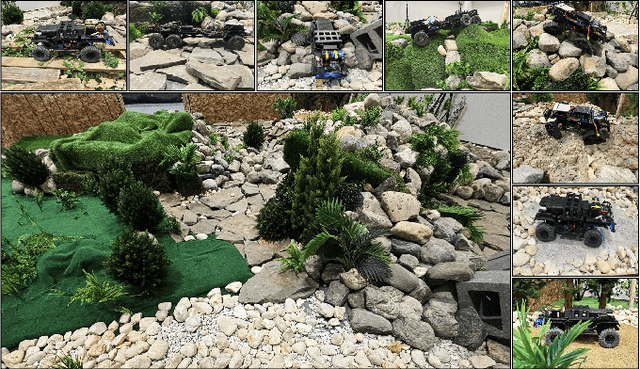
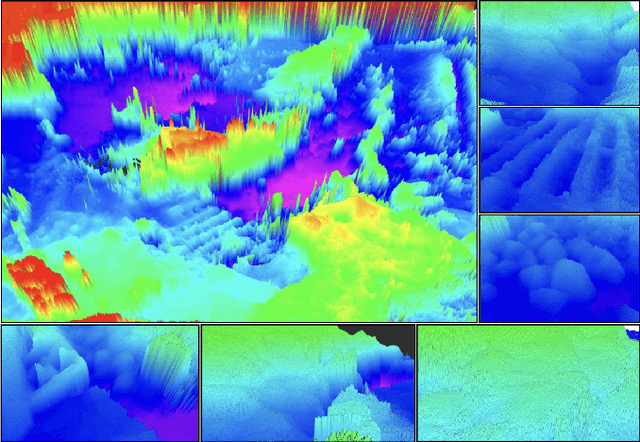
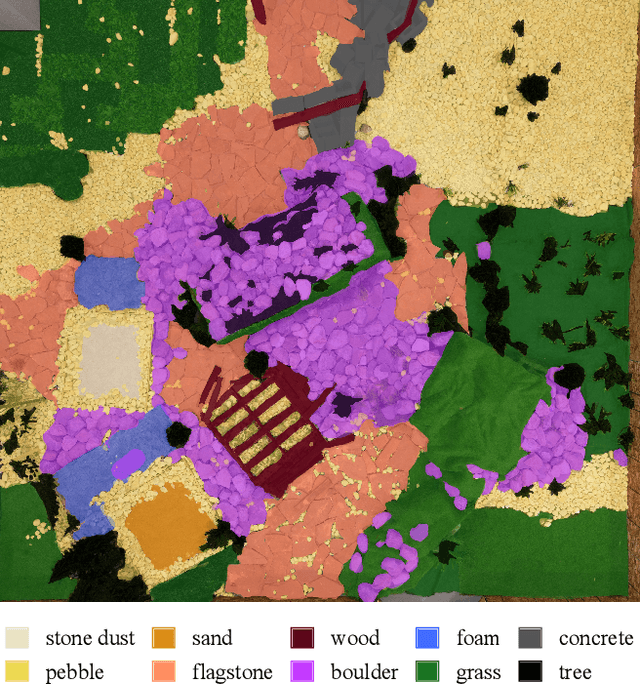
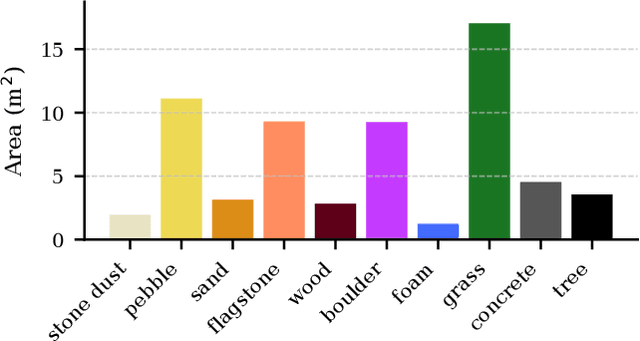
Abstract:Off-road navigation is an important capability for mobile robots deployed in environments that are inaccessible or dangerous to humans, such as disaster response or planetary exploration. Progress is limited due to the lack of a controllable and standardized real-world testbed for systematic data collection and validation. To fill this gap, we introduce Verti-Arena, a reconfigurable indoor facility designed specifically for off-road autonomy. By providing a repeatable benchmark environment, Verti-Arena supports reproducible experiments across a variety of vertically challenging terrains and provides precise ground truth measurements through onboard sensors and a motion capture system. Verti-Arena also supports consistent data collection and comparative evaluation of algorithms in off-road autonomy research. We also develop a web-based interface that enables research groups worldwide to remotely conduct standardized off-road autonomy experiments on Verti-Arena.
Narrate2Nav: Real-Time Visual Navigation with Implicit Language Reasoning in Human-Centric Environments
Jun 17, 2025Abstract:Large Vision-Language Models (VLMs) have demonstrated potential in enhancing mobile robot navigation in human-centric environments by understanding contextual cues, human intentions, and social dynamics while exhibiting reasoning capabilities. However, their computational complexity and limited sensitivity to continuous numerical data impede real-time performance and precise motion control. To this end, we propose Narrate2Nav, a novel real-time vision-action model that leverages a novel self-supervised learning framework based on the Barlow Twins redundancy reduction loss to embed implicit natural language reasoning, social cues, and human intentions within a visual encoder-enabling reasoning in the model's latent space rather than token space. The model combines RGB inputs, motion commands, and textual signals of scene context during training to bridge from robot observations to low-level motion commands for short-horizon point-goal navigation during deployment. Extensive evaluation of Narrate2Nav across various challenging scenarios in both offline unseen dataset and real-world experiments demonstrates an overall improvement of 52.94 percent and 41.67 percent, respectively, over the next best baseline. Additionally, qualitative comparative analysis of Narrate2Nav's visual encoder attention map against four other baselines demonstrates enhanced attention to navigation-critical scene elements, underscoring its effectiveness in human-centric navigation tasks.
CARoL: Context-aware Adaptation for Robot Learning
Jun 08, 2025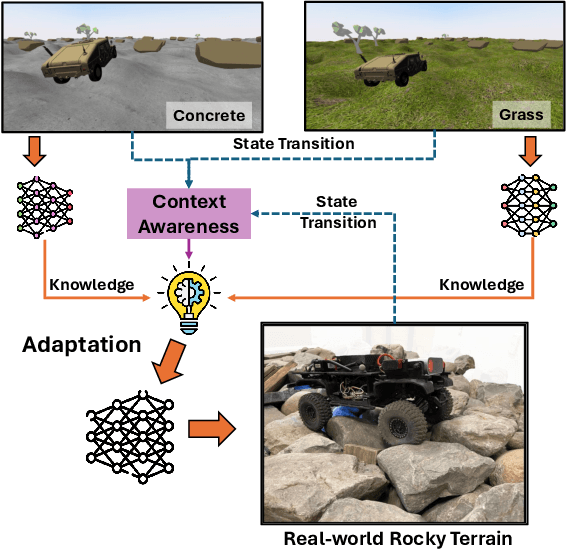
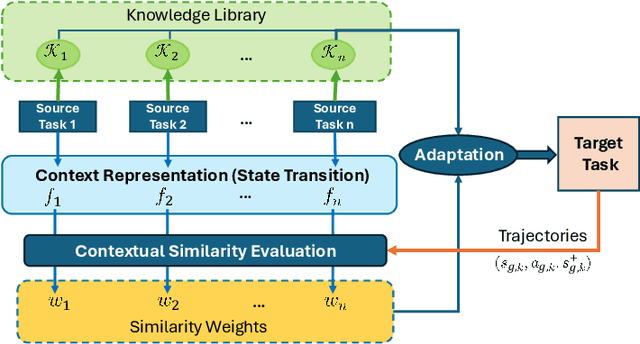
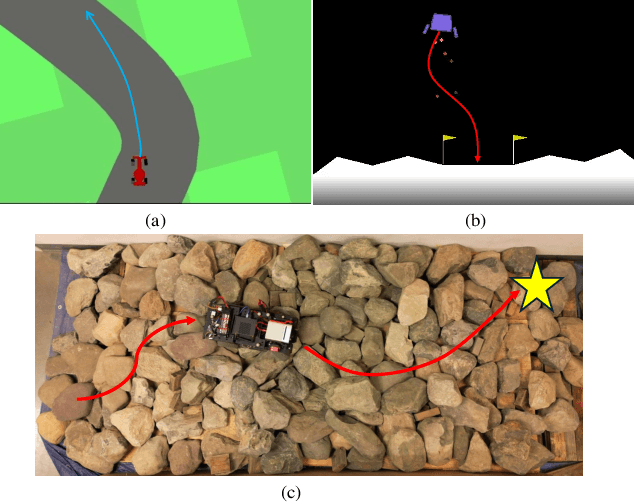
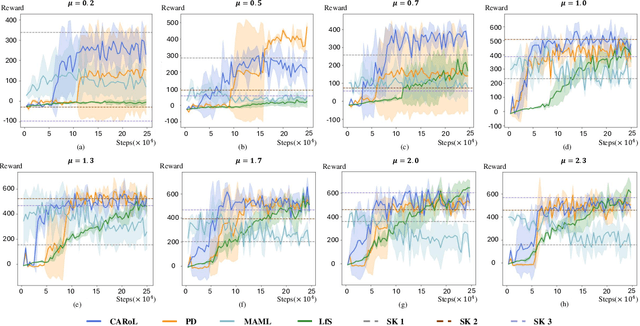
Abstract:Using Reinforcement Learning (RL) to learn new robotic tasks from scratch is often inefficient. Leveraging prior knowledge has the potential to significantly enhance learning efficiency, which, however, raises two critical challenges: how to determine the relevancy of existing knowledge and how to adaptively integrate them into learning a new task. In this paper, we propose Context-aware Adaptation for Robot Learning (CARoL), a novel framework to efficiently learn a similar but distinct new task from prior knowledge. CARoL incorporates context awareness by analyzing state transitions in system dynamics to identify similarities between the new task and prior knowledge. It then utilizes these identified similarities to prioritize and adapt specific knowledge pieces for the new task. Additionally, CARoL has a broad applicability spanning policy-based, value-based, and actor-critic RL algorithms. We validate the efficiency and generalizability of CARoL on both simulated robotic platforms and physical ground vehicles. The simulations include CarRacing and LunarLander environments, where CARoL demonstrates faster convergence and higher rewards when learning policies for new tasks. In real-world experiments, we show that CARoL enables a ground vehicle to quickly and efficiently adapt policies learned in simulation to smoothly traverse real-world off-road terrain.
McARL:Morphology-Control-Aware Reinforcement Learning for Generalizable Quadrupedal Locomotion
May 23, 2025Abstract:We present Morphology-Control-Aware Reinforcement Learning (McARL), a new approach to overcome challenges of hyperparameter tuning and transfer loss, enabling generalizable locomotion across robot morphologies. We use a morphology-conditioned policy by incorporating a randomized morphology vector, sampled from a defined morphology range, into both the actor and critic networks. This allows the policy to learn parameters that generalize to robots with similar characteristics. We demonstrate that a single policy trained on a Unitree Go1 robot using McARL can be transferred to a different morphology (e.g., Unitree Go2 robot) and can achieve zero-shot transfer velocity of up to 3.5 m/s without retraining or fine-tuning. Moreover, it achieves 6.0 m/s on the training Go1 robot and generalizes to other morphologies like A1 and Mini Cheetah. We also analyze the impact of morphology distance on transfer performance and highlight McARL's advantages over prior approaches. McARL achieves 44-150% higher transfer performance on Go2, Mini Cheetah, and A1 compared to PPO variants.
HACL: History-Aware Curriculum Learning for Fast Locomotion
May 23, 2025Abstract:We address the problem of agile and rapid locomotion, a key characteristic of quadrupedal and bipedal robots. We present a new algorithm that maintains stability and generates high-speed trajectories by considering the temporal aspect of locomotion. Our formulation takes into account past information based on a novel history-aware curriculum Learning (HACL) algorithm. We model the history of joint velocity commands with respect to the observed linear and angular rewards using a recurrent neural net (RNN). The hidden state helps the curriculum learn the relationship between the forward linear velocity and angular velocity commands and the rewards over a given time-step. We validate our approach on the MIT Mini Cheetah,Unitree Go1, and Go2 robots in a simulated environment and on a Unitree Go1 robot in real-world scenarios. In practice, HACL achieves peak forward velocity of 6.7 m/s for a given command velocity of 7m/s and outperforms prior locomotion algorithms by nearly 20%.
Decremental Dynamics Planning for Robot Navigation
Mar 26, 2025Abstract:Most, if not all, robot navigation systems employ a decomposed planning framework that includes global and local planning. To trade-off onboard computation and plan quality, current systems have to limit all robot dynamics considerations only within the local planner, while leveraging an extremely simplified robot representation (e.g., a point-mass holonomic model without dynamics) in the global level. However, such an artificial decomposition based on either full or zero consideration of robot dynamics can lead to gaps between the two levels, e.g., a global path based on a holonomic point-mass model may not be realizable by a non-holonomic robot, especially in highly constrained obstacle environments. Motivated by such a limitation, we propose a novel paradigm, Decremental Dynamics Planning that integrates dynamic constraints into the entire planning process, with a focus on high-fidelity dynamics modeling at the beginning and a gradual fidelity reduction as the planning progresses. To validate the effectiveness of this paradigm, we augment three different planners with DDP and show overall improved planning performance. We also develop a new DDP-based navigation system, which achieves first place in the simulation phase of the 2025 BARN Challenge. Both simulated and physical experiments validate DDP's hypothesized benefits.
Dom, cars don't fly! -- Or do they? In-Air Vehicle Maneuver for High-Speed Off-Road Navigation
Mar 24, 2025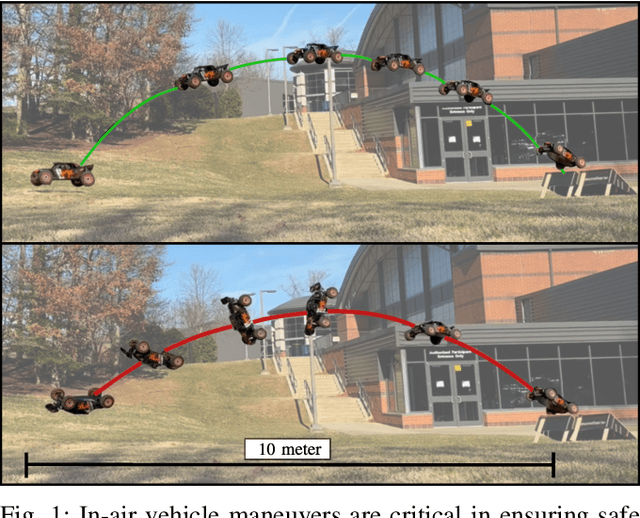
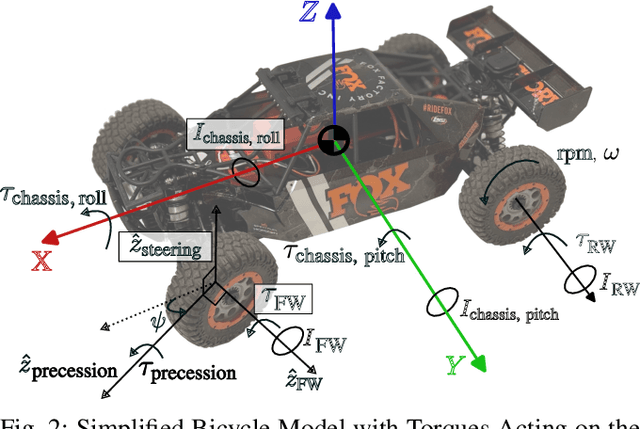
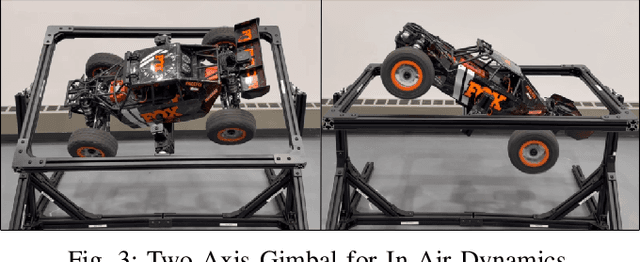
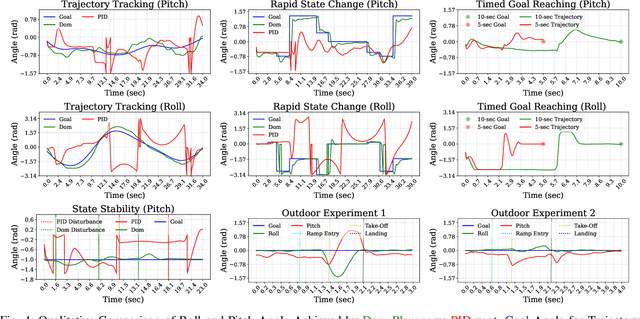
Abstract:When pushing the speed limit for aggressive off-road navigation on uneven terrain, it is inevitable that vehicles may become airborne from time to time. During time-sensitive tasks, being able to fly over challenging terrain can also save time, instead of cautiously circumventing or slowly negotiating through. However, most off-road autonomy systems operate under the assumption that the vehicles are always on the ground and therefore limit operational speed. In this paper, we present a novel approach for in-air vehicle maneuver during high-speed off-road navigation. Based on a hybrid forward kinodynamic model using both physics principles and machine learning, our fixed-horizon, sampling-based motion planner ensures accurate vehicle landing poses and their derivatives within a short airborne time window using vehicle throttle and steering commands. We test our approach in extensive in-air experiments both indoors and outdoors, compare it against an error-driven control method, and demonstrate that precise and timely in-air vehicle maneuver is possible through existing ground vehicle controls.
Reward Training Wheels: Adaptive Auxiliary Rewards for Robotics Reinforcement Learning
Mar 19, 2025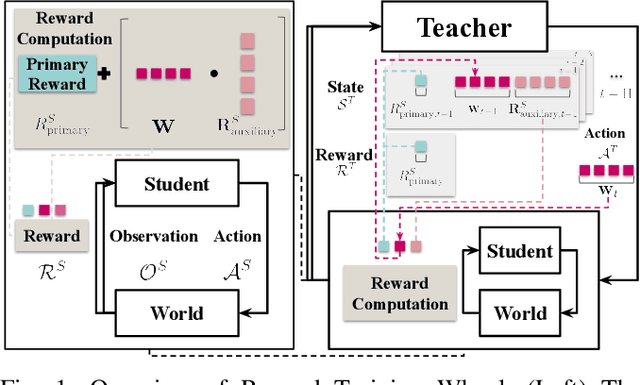
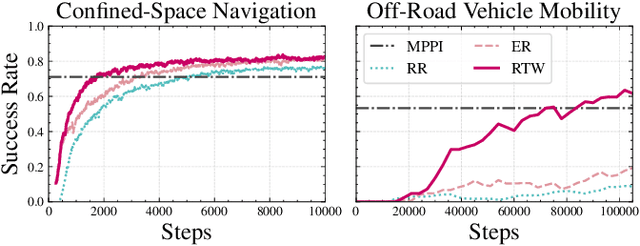
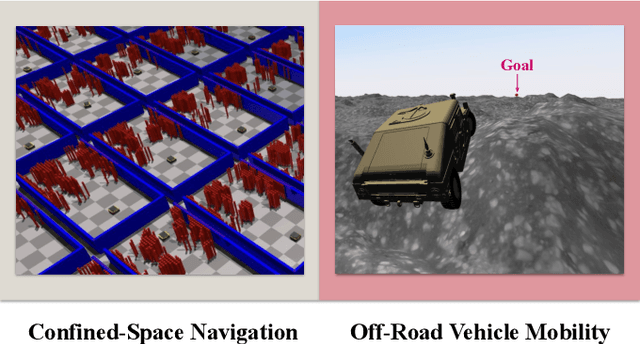
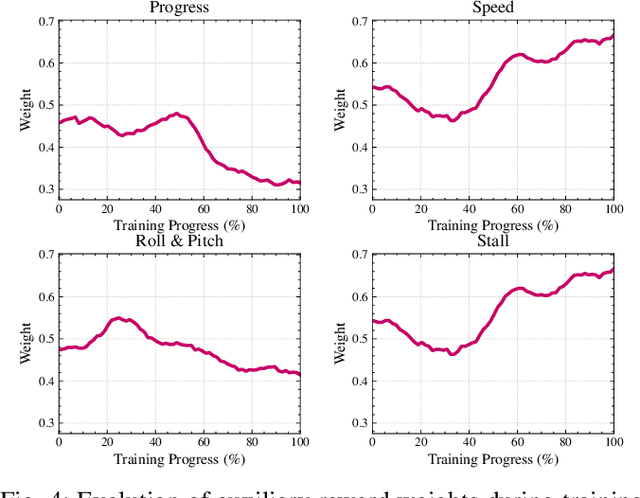
Abstract:Robotics Reinforcement Learning (RL) often relies on carefully engineered auxiliary rewards to supplement sparse primary learning objectives to compensate for the lack of large-scale, real-world, trial-and-error data. While these auxiliary rewards accelerate learning, they require significant engineering effort, may introduce human biases, and cannot adapt to the robot's evolving capabilities during training. In this paper, we introduce Reward Training Wheels (RTW), a teacher-student framework that automates auxiliary reward adaptation for robotics RL. To be specific, the RTW teacher dynamically adjusts auxiliary reward weights based on the student's evolving capabilities to determine which auxiliary reward aspects require more or less emphasis to improve the primary objective. We demonstrate RTW on two challenging robot tasks: navigation in highly constrained spaces and off-road vehicle mobility on vertically challenging terrain. In simulation, RTW outperforms expert-designed rewards by 2.35% in navigation success rate and improves off-road mobility performance by 122.62%, while achieving 35% and 3X faster training efficiency, respectively. Physical robot experiments further validate RTW's effectiveness, achieving a perfect success rate (5/5 trials vs. 2/5 for expert-designed rewards) and improving vehicle stability with up to 47.4% reduction in orientation angles.
 Add to Chrome
Add to Chrome Add to Firefox
Add to Firefox Add to Edge
Add to Edge